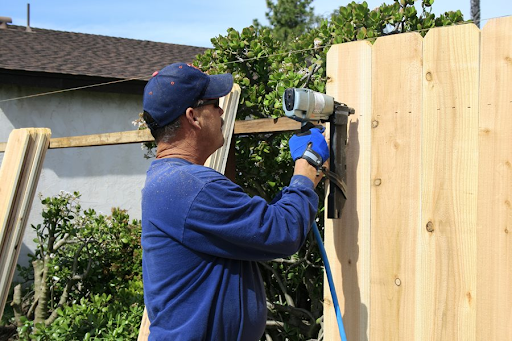Fencing plays a pivotal role in enhancing the aesthetics, security, and privacy of residential properties. Choosing the right fence material and installation strategy is crucial for ensuring durability and functionality. This article delves into the top fence materials and the best practices for installation, with a focus on the expertise of residential fence installers and the nuances of Wood Fencing Installation.
Top Fence Materials: A Comprehensive Overview
When selecting a fence material, it’s essential to consider factors such as durability, maintenance requirements, and aesthetic appeal. Here are some of the most popular fencing materials:
1. Wood Fencing
Wood fencing remains a timeless choice due to its natural beauty and versatility. It can be customized to fit various styles, from classic picket fences to more robust privacy fences.
Advantages:
- Aesthetic Appeal: Wood offers a warm, classic look that can be stained or painted to match any exterior.
- Customizability: Wood fences can be tailored to various heights and styles to fit specific needs and preferences.
Disadvantages:
- Maintenance: Wood requires regular maintenance to prevent decay and damage from pests. This includes staining, painting, and occasional repairs.
- Durability: While sturdy, wood can be susceptible to weather-related wear and tear over time.
2. Vinyl Fencing
Vinyl fences are known for their durability and low maintenance requirements. They are available in various styles and colors, mimicking the appearance of wood or offering a more modern look.
Advantages:
- Low Maintenance: Vinyl does not require painting or staining and is resistant to pests and weather.
- Durability: It is highly resistant to impact, rot, and fading.
Disadvantages:
- Cost: Vinyl can be more expensive than wood or other materials.
- Limited Customization: While available in different styles, vinyl may not offer the same level of customization as wood.
3. Metal Fencing
Metal fences, including options like aluminum and wrought iron, offer a robust and elegant solution for both security and aesthetics.
Advantages:
- Strength: Metal fences are highly durable and resistant to damage.
- Low Maintenance: Most metal fences require minimal upkeep, especially aluminum, which resists rust.
Disadvantages:
- Cost: Metal fencing can be quite costly, particularly wrought iron.
- Limited Privacy: Metal fences typically offer less privacy compared to solid materials like wood or vinyl.
4. Composite Fencing
Composite fencing combines wood fibers and plastic to create a durable, low-maintenance material that mimics the look of wood.
Advantages:
- Durability: Composite materials are resistant to rot, pests, and weathering.
- Low Maintenance: Requires minimal upkeep compared to traditional wood.
Disadvantages:
- Cost: Composite fencing can be more expensive than traditional wood or vinyl.
- Aesthetic Limitations: While it resembles wood, it may lack the authentic texture and warmth.
Residential Fence Installer: The Key to a Successful Installation
Choosing a reputable Residential fence installer is crucial for ensuring that your fence is installed correctly and efficiently. Here are key considerations when hiring a fence installer:
1. Experience and Expertise
An experienced residential fence installer will have the knowledge and skills to handle various fence materials and installation techniques. They can provide valuable insights into the best material for your needs and ensure proper installation.
2. Licensing and Insurance
Ensure that the installer is licensed and insured. This protects you from potential liability and ensures that the installer adheres to local regulations and standards.
3. References and Reviews
Check references and read reviews from previous clients. This will give you an idea of the installer’s reliability, workmanship, and customer service.
4. Detailed Estimates
Request detailed estimates from multiple installers. This should include the cost of materials, labor, and any additional fees. Compare these estimates to ensure you are getting a fair price for quality work.
Wood Fencing Installation: Best Practices for a Lasting Fence
Wood fencing, while versatile and aesthetically pleasing, requires careful installation to ensure longevity and performance. Here are some best practices for wood fencing installation:
1. Proper Site Preparation
Before installation, prepare the site by clearing any debris, rocks, or vegetation. This will ensure a stable foundation for your fence posts and prevent future issues.
2. Quality Materials
Use high-quality, pressure-treated wood that is resistant to rot and insects. Ensure that all wood components are properly treated and sealed before installation.
3. Accurate Measurements
Measure your fence line accurately to determine the correct number of posts and panels required. This will help avoid overordering or underordering materials and ensure a smooth installation process.
4. Secure Post Installation
Posts are the backbone of your fence, so ensure they are set securely in concrete to prevent shifting or leaning. Posts should be placed at least one-third of their length into the ground.
5. Regular Maintenance
After installation, maintain your wood fence by regularly inspecting it for signs of wear or damage. Reapply stain or paint as needed to protect the wood from the elements and extend its lifespan.
Conclusion
Choosing the right fence material and installation strategy is crucial for enhancing the beauty, security, and functionality of your home. Whether opting for wood, vinyl, metal, or composite fencing, it’s essential to consider your specific needs and preferences. Engaging a skilled residential fence installer and following best practices for wood fencing installation will ensure that your investment provides long-lasting value and satisfaction. By carefully evaluating your options and prioritizing quality installation, you can enjoy a well-designed and durable fence for years to come.
